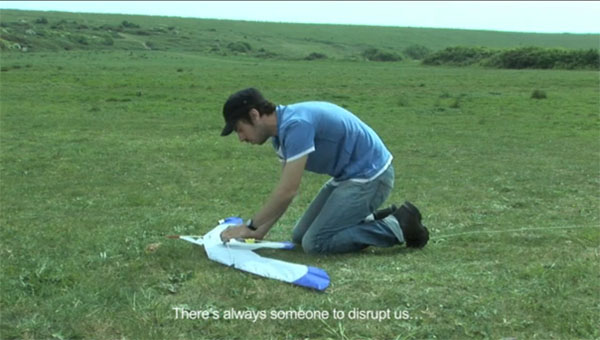It says here that ROSIE & RIVETTE (Maraula, 13 mins) is a “bright and breezy homage to the French New Wave”. If film is a language then the challenge—especially in short forms—is to say something new in that language by using it in a new way, or else to so thoroughly explore the idiom and cliches of the language that the references to and invocations of the old become new. Maraula manages neither in what is, bar the product shot missing from the end, a tiresome extended perfume commercial. The name of the perfume would have a ‘!’ in it. You know the sort of thing.
In SHE DON’T LOOK BACK (Brown, 8 mins) Christopher Brown has plonked a near static camera in front of a set which achieves not so much an expressive, expressionistic, brooding minimalist menace (which was probably intended) as an overwhelming air of shoddy cheapness. The cast are mute and yet still manage to deliver performances of remarkable inarticulacy. There are soldiers, so … something about war? War is … bad, perhaps? 6th-form stuff.
Oliver Newport delivers a superficially touching sub-Louis-Theroux miniature, a claustrophobic slice of a demented life in KATY & I (Newport, 4 mins). The subject is a preposterous, obsessive “fan” of “singer” Katy Perry. Is this silly person real or some po-mo confabulation of the film-maker? The mechanics of the filming are exposed to the viewer, which might be a hint. Or not. I neither know nor care. If he is real there is every chance he will eventually feature in some sub-Adam-Curtis piece about a dreadful atrocity.
SOUTHDOWN BUS (Perez, 5 mins) makes very effective use of the sophisticated facilities for visual manipulation available to even the short-film director these days to make a poetic monologue into an engaging film. A combination of animation, rotoscoping and manipulated realistic images in the style of a modern comic enhance the poet’s performance while respecting his material. This is what short film making should be like, playing to the strengths of the form. This technique would be wearing in a longer format but makes a fun 5 minutes. The work of an artist who uses film, not a film–maker who might make some art if you’re lucky.
Short films should be lapidary: crisp, formally constructed, precise, clean, smooth, polished, and with hidden depths. MAN & SEAGULL (Scurr, 4mins) is all of that. In less than five minutes Scurr creates sympathetic characters that the viewer wants to know more about, and puts them in a beautiful setting carefully photographed. The story reaches a pleasant closure within the bounds of the film and yet is open–ended enough to stimulate the audience’s imaginations. Perfect.
MARVIN (Nute, 7 mins) shows what spending money can do for you. Steve Coogan narrates this trite animated tale. The eponymous Marvin goes on a silly-ish adventure and learns the sort of life lesson that middle–brow middle–class parents think they would like to think they want their children to learn. But which if they thought about it at all carefully would have them run screaming from the room. Slick. Vapid. Nugatory.
In BORDERLAND (Steer, 14 mins) we are faced with with a grimly, persistently, self–consciously “relevant” story about a journo for some ghastly rag having her moral compass re–oriented by a series of meetings with a stereotype. The stereotype even tells us that she’s a stereotype. Just in case we missed the point. Steer seems to be setting out to make a certain kind of viewer very uncomfortable with themselves without realising that exactly the kind of viewer he wants to skewer wouldn’t watch this film if you paid them. Self–indulgent preachy trash of the kind that Channel 4 used to put on late at night before they sold out.
In THE CENTRE (Lloyd, 14 mins) we meet a bunch of regular working stiffs who attend a fictional vaguely new–age–y self–help sort of retreat thing. They play silly bonding games, they meditate, they carry out menial tasks with the air of a Zen monk, they deliver unaffected monologues to camera about their experiences with The Centre and the benefits to their lives. It’s all very carefully judged and directed by Lloyd with an extremely light touch in a very straight documentary style—albeit with somewhat more careful framing than most documentary makers would bother with. Almost like one of those ambiguous paintings that psychologists use this film invites the audience to consider what they think about the things that people do to get them through the day, the cultural borrowings they make, the structures they build around the problems in their lives and the solutions to them. And maybe to get a surprise.

